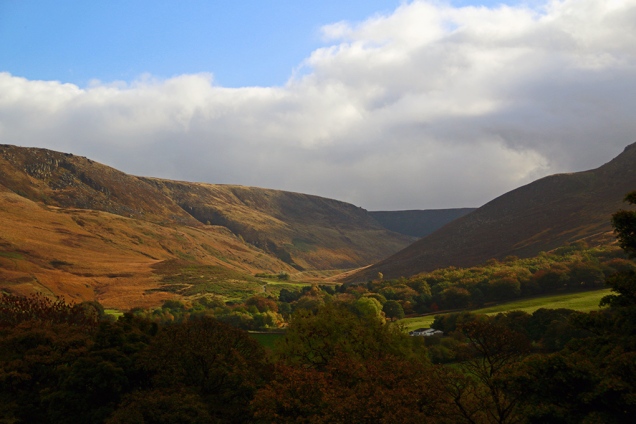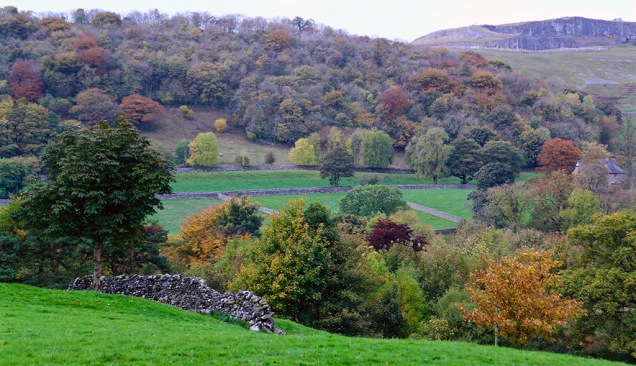 Dales photo opportunities have been rare for me recently but I have managed a couple of quick forays up Ribblesdale. As is usual in the Dales, the colour and appearance of trees can change quickly as the wind from exposed fells whistles from all directions through the valleys, and the temperature away from the towns drops rapidly. There are pockets of trees all around this sheep-munched region so autumn in the Dales is still a joy. Top photo shows Stainforth Scar as seen from the road to Knight Stainforth.
Dales photo opportunities have been rare for me recently but I have managed a couple of quick forays up Ribblesdale. As is usual in the Dales, the colour and appearance of trees can change quickly as the wind from exposed fells whistles from all directions through the valleys, and the temperature away from the towns drops rapidly. There are pockets of trees all around this sheep-munched region so autumn in the Dales is still a joy. Top photo shows Stainforth Scar as seen from the road to Knight Stainforth.

The other week I stopped off at Hellifield Flashes to pay my respects after being shocked by the decision of Yorkshire Dales National Park and the RSPB to withdraw their objections to totally inappropriate development plans for the area. Thankfully the CPRE and local campaigning groups haven’t similarly turned their backs. At a planning meeting this week the council didn’t come to any firm decision and said they ‘wanted to walk the area’. You’d have thought that after umpteen years of receiving planning requests for this green space they would have done that already.
https://www.facebook.com/pages/category/Community/saveourcravencountryside-108150632557939/

I attended the launch of a booklet called ‘Fifty Years On – Securing North Craven’s Heritage’, at the Folly in Settle last week. In his introduction to the publication playwright Alan Bennett comments: “The planning process is still weighted against conservation with the proposed development at Hellifield Flashes a good example. The planning set up is weighted in favour of a developer who, faced with opposition, can submit an amended plan as often as is required with the opposition eventually worn down and the developer winning by process of attrition.”
I’m not being NIMBY about this, but looking at the number of housing developments and applications being submitted for our region it’s obvious that developers are seeing this edge of the National Park boundary along the A65 and Settle as being an easy and profitable area – and that Craven Council are more than happy to tick off a few boxes of targets set by a distant and uncaring government. ‘Nobody wants a suburban Craven’ says Alan – I’m not sure about ’nobody’, Mr Bennett.
The splendid booklet celebrates 50 years combined work by the Settle & District Civic Society, North Craven Heritage Trust, North Craven Building Preservation Trust and Museum of North Craven Life. It is available from the Folly in Settle and other outlets.


Being confined to quarters for longer than usual I’ve watched a bit more television than normal and come to the conclusion that the majority of programmes are not aimed at me. I’ve never managed to watch a whole Strictly or Big Brother; or anything that contains wannabes or celebrities (what is a celebrity? I thought a celeb was someone I would recognise – but apparently not). I don’t do soaps at all (I use them now and then). There is one TV programme about people watching TV programmes and loads more where we witness people cooking meals, baking cakes or painting their houses. Programme announcers drive me mad with their smirky tone and drawn-out last syllables. When it comes to adverts I’m not the type of person to be persuaded to buy my insurance by a stuffed mammal or an opera singer; and don’t get me started on what is described as ‘The News’. Then there are those annoying programmes where they tell you what’s coming up beforehand, tell you again before every ad break, then give us a reprise of what happened before the break because we’re not capable of remembering what we were watching three minutes ago. I realise that many people who work full time need to switch on their tellies and ‘switch off’ their minds but… please let me back out into the Dales.


Great to see that the Blue Plaque Society will recognise the achievements of icon of the Dales Bill Mitchell with the unveiling of a plaque (7th December 2018) at Skipton Parish Church Primary School. Bill was a pupil there and the idea of a plaque was put forward by Bill’s son David who said:
“My father dedicated himself to writing about Yorkshire for over 60 years. He was editor of the Dalesman for twenty years and wrote over 200 books as well as hundreds of articles. He delivered innumerable talks and conducted countless interviews with Yorkshire characters. Many are contained in the WR Mitchell Archive, available online. Yorkshire TV marked his retirement with a programme about his life, narrated by Alan Bennett. He received an MBE in 1996 and was made an honorary Doctor of Letters by the University of Bradford. He was the first patron of the Yorkshire Dales Society. September 2009 saw him voted ‘Greatest Living Icon’ for the Yorkshire Dales National Park. In April 2014 he was voted 33 in a poll to find the 75 Greatest Icons of Yorkshire. Much much more is covered in his Wikipedia entry. There cannot be many parts of our great county that haven’t been touched by his magical presence. My sister and I are very proud of him”.



















































































































